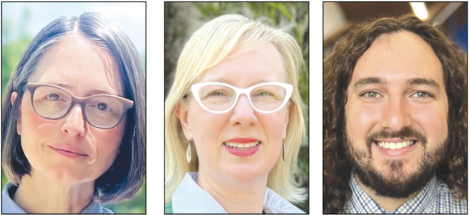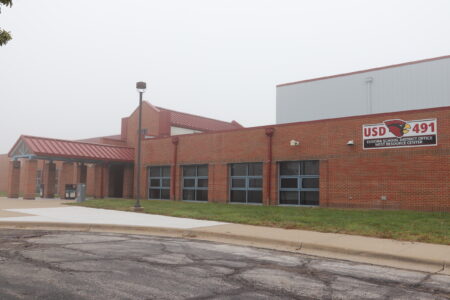Southwest Middle School students earn special recognition at Future City finals in Washington, D.C.

photo by: Contributed
Southwest Middle School's Future City team poses for a group picture during the Future City Competition, held Feb. 16-19 in Washington, D.C.
More than two dozen students from Lawrence’s Southwest Middle School received special recognition at the recent Future City Competition international finals in Washington, D.C.
The group, representing the Great Plains Future City Kansas-KC Metro Region, brought home the “Outstanding Future City Plan Award,” which recognized the team’s intensive planning and project management efforts. Last weekend’s award, presented by the Educational Foundation Project Management Institute, was one of more than 20 special recognition awards given out.

photo by: Contributed
The Southwest Middle School project that was presented at the recent Future City Competition, held Feb. 16-19 in Washington, D.C.
For the competition, SWMS students researched innovative technologies, then projected them 100 years into the future, using Karachi, Pakistan, a metropolis with over 15 million people, as their blueprint. The competition began with the question “How can we make the world a better place?” The students were then tasked with researching, designing and building cities of the future that showcase their solution to a citywide sustainability issue. The competition included multiple components: a 1,500-word essay; a scale model (or multiple model segments) built from recycled materials; a phased project plan; a presentation video; and a Q&A session with judges.
The event was focused on ways that “clean, green, and renewable energy sources could power the electrical grid,” as well as how those “sources generate enough electricity for industry, transportation, agriculture, residential, and commercial uses,” according to a news release about the contest.
SWMS teacher Danielle Lotton-Barker guided the students through months of preparation, which included a first-place finish at last month’s Future City Competition regional finals. Lotton-Barker said that the group devised a corporate team structure for the project — with a number of project managers working under the principal architect/engineer.
Lotton-Barker said that her students were the only team that used a Gantt chart, which is a tool that helps manage deadline-driven tasks. The Gantt chart typically displays a timeline of completed work and outlines relevant tasks.
“It’s a tool that project managers use, and so that’s another reason that our kids did well,” Lotton-Barker said.
Logan Harned, one of the team’s three presenters at the competition, has a unique connection to the Gantt chart, which was popularized by Henry Gantt in the early 20th century.
“His grandpa worked for the company where the Gantt chart was invented, so it was kind of cool that we won that award,” Lotton-Barker said. “And his grandpa was at the competition watching.”
Lotton-Barker said the group had to raise funds to make the trip, and they set a goal of $15,000.
“The first thing is that we wanted to be able to cover any kids that couldn’t go because of financial needs,” she said.

photo by: Contributed
Members of Southwest Middle School’s Future City team take a tour of the United States Capitol during their recent trip to Washington, D.C., for the Future City Competition. Here they pose with a statue of aviator Amelia Earhart, center.
The six-day trip included ample sightseeing in the nation’s capital, as the group toured the Capitol, took a nighttime walk to the Washington Monument and visited several museums. Lotton-Barker said the group received a “special tour” at the National Museum of African American History and Culture, thanks to a connection that one of the parents had with the museum’s director.
“So she was able to get us in an hour early for a guided tour,” Lotton-Barker said, “which was amazing.”
SWMS eighth grader Max Bolick, a member of the team, said that the visit to that museum was a highlight of the trip.
“It was just really special,” he said. “The architecture was amazing and there was some beautiful art. And if I’m being completely honest, I think that it inspired me to become an architect.”
Bolick described the competition itself as an immersive experience in which the SWMS Future City team was able to “meet people … from all over the world.” And the project itself presented unique challenges, Bolick said.
“There were a lot of us in the group, and so we did have some differing opinions,” Bolick said. “Our deadlines (for the various tasks) were a big challenge. But you really learn to work with people — and, with teamwork, make something that you can be proud of, while learning how to resolve disagreements.”

photo by: Contributed
Southwest Middle School students make adjustments to their project during the Future City Competition, held Feb. 16-19 in Washington, D.C.
As far as projecting Karachi 100 years into the future, Bolick said the team modeled its project “after the traditional architectural and cultural style that’s there now,” and the group aimed “to preserve people’s way of life there.”
Having worked on the project since August, Bolick said that he gained a lot of insight into the engineering-design process.
“You learn about cool building techniques,” Bolick said, “and futuristic technologies (relating) to how we can save the world from things like climate change.”
The SWMS students representing the region at the national competition were Max Bolick, Chloe Carnagey, Penny Coleman, Aila Glendening, Ainslee Graham, Logan Harned, Ryan Hethcoat, Celeste Jenkins, Juliet Johnson, Hailey Kim, Isaac Perrins, Nina Wilson, Caroline Davis, Winry Eymard, Ruby Fritzel, Aiden Gonzalez, Tola Jankowski, Savannah Lynch, Kate Neilson, Henry Roberts, Cooper Salmans, Allen Shao, Laurel Stancil, Nate Willems and Ruth Yang.
The trip to the finals was the ninth for the school.

photo by: Contributed
Southwest Middle School students and chaperones do some nighttime sightseeing during their recent six-day trip to Washington, D.C.




